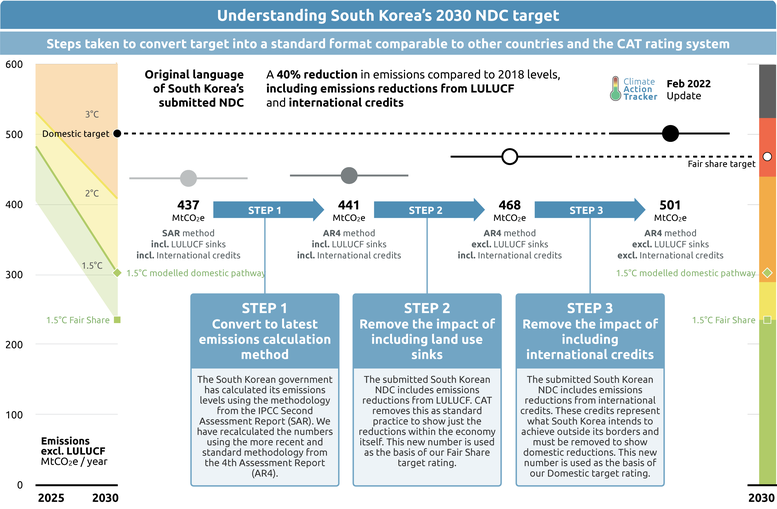CAT Climate Target Update Tracker
South Korea
Summary
South Korea announced its updated NDC in October 2021 ahead of COP26, pledging to reduce 2030 emissions by 40% below 2018 levels, including reductions from land-use, land-use change and forestry (LULUCF) and international credits. The target was submitted to the UNFCCC on December 23rd, 2021.
This target is a significant improvement compared to South Korea’s previous NDC of 24.4% below 2017 levels but falls short of what is needed globally to meet the Paris Agreement’s 1.5°C temperature limit. Deducting the suggested contribution of forestry and reductions overseas, the target translates to a 32% reduction of domestic emissions by 2030 below 2018 levels. To meet the Paris Agreement’s 1.5°C warming limit, the CAT estimates that a domestic emissions reduction of at least 59% by 2030 is needed.
CAT analysis of NDC announcement

In October 2021, the South Korean government announced an updated NDC target to reduce emissions by 40% below 2018 levels by 2030, and submitted this update to the UNFCCC in December 2021. South Korea’s 2020 and 2021 NDC targets are relative to base year emissions excluding LULUCF but rely on reductions from LULUCF sinks and international credits to meet the targeted levels in 2030.
The absolute emissions target communicated by the government is 437 MtCO2e (SAR), including reductions from LULUCF and international credits. We converted this value to AR4 to ease comparison of country targets (see assumptions). We estimate the absolute emissions target in AR4 is 441 MtCO2e (Figure). The new target significantly strengthens the 2030 target from the 24.4% reduction below 2017 emissions in the December 2020 NDC submission, which in absolute terms is 541 MtCO2e (AR4).
The 2021 NDC update envisages a greater role for LULUCF sinks, which increased from -22.1 to -26.7 MtCO2e, and a much greater role for international credits, which doubled from -16.2 to -33.5 MtCO2e.
The new NDC improves the CAT fair share target rating from “Critically Insufficient” to “Highly Insufficient”, while the domestic target rating remains “Insufficient”. In absolute terms, the CAT estimates the new NDC reduces South Korea’s fair share target (excl. LULUCF, incl. international credits) from 563 to 468 MtCO2e and its domestic target (excl. LULUCF and international credits) from 579 to 501 MtCO2e (32% reduction below 2018 levels).
While the new target represents a significant improvement to the country’s 2030 target submitted in December 2020, it is not yet aligned to what is needed globally to meet the Paris Agreement’s 1.5°C temperature limit. Our analysis shows South Korea would need to further increase its current 2030 climate target to a 59% reduction below 2018 emissions (equivalent to an absolute national emissions level of 302 MtCO2e excl. LULUCF in 2030—within its borders and excluding offsets) for it to be compatible with a 1.5°C pathway.

Assumptions
Global Warming Potential (GWP) values
South Korea uses GWP values from the IPCC’s Second Assessment Report (SAR). We converted to AR4 GWP values to ease comparison of countries’ targets and emission trajectories.
South Korea formulates its target as a percent reduction from base year emissions that exclude LULUCF but plan to use reductions from LULUCF sinks and international credits to meet its target in 2030. The contributions of LULUCF sinks and international credits in the 2020 and 2021 NDCs are detailed in the NDC Upgrade Plan. We exclude reductions from LULUCF sinks to obtain the CAT fair share target and further exclude reductions from international credits to obtain the CAT domestic target.
We recalculate the 2020 NDC with this information on the contribution of LULUCF sinks and international credits. This results in a 1 MtCO2e increase from our previous calculations that used assumptions on the use of LULUCF and international credits from South Korea’s first NDC (see assumptions in September 2021 assessment).
For more detail, please read our full country assessment from March 2022.
Links
Stay informed
Subscribe to our newsletter
